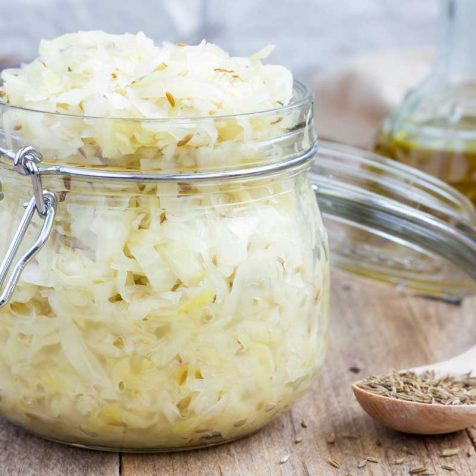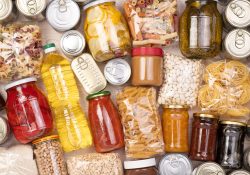Sauerkraut

Description
Sauerkraut is perhaps the best-known style of fermented vegetable in our country and also happens to be one of the simplest to make at home. The ingredient list is short, the steps are simple, and the margin for error is extremely low. In fact, famed fermentation revivalist Sandor Katz points out that the large population of lactic acid bacteria present in the ferment handily outcompete any incidental pathogenic bacteria, and the acidity that rapidly develops in fermented vegetables destroys any remaining pathogens. Lactic acid bacteria are present on cabbages and all other raw vegetables and they’re largely responsible for the magical transformation that takes place when you pack cabbage and salt together into a jar. Our ability to use microbes — fungi (yeasts) and bacteria — as a method of food preservation dates back to the dawn of recorded history. Prior to refrigeration, it was the only way, short of sun-drying, to preserve food. It is a process that is inextricably linked to our culture as human beings. It is, in large part, responsible for our survival as human beings as it allowed our earliest ancestors to preserve and store food to get through long winters and periods of famine. Fermentation also makes our food more nutritious, more flavorful, and easier to digest. Fermented foods deliver a healthy dose of living probiotic bacteria and enzymes to our overall intestinal flora, increasing the health of our gut microbiome. Even though the practice of fermentation has been around for centuries, we are just beginning to understand, from a scientific point of view, why fermented foods are so important for our health. The forty-odd trillion microbes that live on and in our bodies allow us to digest food and produce key minerals that nourish us and protect us from disease. They guide the development of our bodies, are key to the healthy functioning of our immune systems, and influence our behavior. They even modulate the expression of our genes, bind with and remove toxins from our bodies, prevent or lessen the effects of food allergies, and communicate with the nervous system using some of the same neurochemicals that relay messages to the brain (the Gut-Brain Axis). They secrete a profound number of chemicals, many of which are the same chemicals used by our neurons to regulate our mood and signal appetite clues like hunger and fullness. Our weekly sale from April 21st – 27th celebrates foods that promote gut health, so what better time to try whipping up a batch of your very own probiotic-packed sauerkraut?
Instructions
Peel away the outermost leaf from the cabbage and set it aside. Shred the remaining cabbage finely and relatively uniformly. Place shredded cabbage into a large bowl and sprinkle in the salt and spices (if using). Using your hands, mix and mash the cabbage thoroughly. This should bruise the cabbage, breaking it down and allowing it to release its juices. Once you’ve mashed your cabbage for a while, it should be very juicy and reduced in overall volume. Pack the shredded cabbage firmly into a clean quart-sized jar. After packing it all into the jar, pour the brine remaining in the bowl over the cabbage so that all of the cabbage is submerged in liquid. If there’s not enough liquid you may add non-chlorinated water. Leave an inch or so of headspace at the top of your jar. Place the large outer cabbage leaf into the jar, covering and submerging the shredded cabbage. If you have a fermentation weight, you could place that on top to keep the cabbage submerged. Cap your jar with an airlock lid, a loose jar lid, or a clean kitchen towel. Move to an area out of direct sunlight and with a relatively stable temperature. The ideal temperature range for optimal fermentation is 65 – 72 degrees. Warmer temperatures will facilitate a more rapid fermentation. As for how long to leave your ferment, the best thing to do is to taste it at various intervals. Some will love the mild flavors and crunchy texture of a short-term ferment, while others prefer more mature, longer-aged ferments. The numbers and concentration of the probiotics present in the ferment follow a bell curve, building to a peak after veggies are submerged, then declining at high levels of acidity. When the kraut has reached your preferred level of crunchy sour tartness, place a normal cap on the jar and move it to the fridge. It will keep for many months and will mellow with age.



